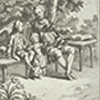Met fictieve peers op zoek naar de waarheid. Fictie als didactisch instrument in Verlicht-religieuze catechismussen van Samuel van Emdre (1781-1798)
DOI:
https://doi.org/10.18352/bmgn-lchr.10224Keywords:
History, Low Countries, enlightenment, catechismAbstract
Searching for Truth with Fictional Peers: Fiction as a Didactic Instrument in the Enlightenment Religious Catechisms of Samuel van Emdre (1781-1798)
Following the recent trend in scholarship that considers the Enlightenment as a dynamicprocess of Christian civilisation rather than secularisation, this article analyses how the Reformed minister Samuel van Emdre used catechisms to create an Enlightened religion. As a late eighteenth century catechist Van Emdre faced an intriguing didactic paradox: while the genre of the catechism served to teach religious knowledge unambiguously, new Enlightened ideals of learning emphasised the value of curiosity and an active, searching learning style. This article shows how he resolved this paradox by introducing fictional strategies: increasingly he used fictional peers, interactive dialogue techniques and stylistic diversity. By these means, Van Emdres’ catechisms invited youngsters to model themselves upon their young peers in the texts and to absorb religious knowledge acquired and investigated independently.
Aanhakend bij de recente historiografische tendens om de Nederlandse Verlichting te zien als een dynamisch beschavingsproces in plaats van een seculariseringsbeweging, analyseer ik in dit artikel hoe de predikant Samuel van Emdre een Verlichte religie creëerden in catechismussen. Als laatachttiende-eeuwse catecheet werd Van Emdre geconfronteerd met een didactische paradox: aan de ene kant was het catechismusgenre erop gericht om onwankelbare religieuze kennis over te dragen, maar aan de andere kant werd – in lijn met nieuwe Verlichte pedagogische idealen – belang gehecht aan nieuwsgierigheid en onderzoekende leerstijlen. Dit artikel laat zien hoe Van Emdre die paradox oploste door fictionele strategieën in zijn catechismussen te introduceren: hij gebruikte steeds meer fictieve peers, interactieve dialoogtechnieken en genrecombinaties. Daarmee nodigde hij jongeren uit om zichzelf te spiegelen aan de personages in de teksten. Jonge lezers maakten zich op deze manier religieuze kennis eigen alsof het zelfstandig verworven overtuigingen betrof.
Downloads

Published
Issue
Section
License
Authors who publish with this journal agree to the following terms:
a) Authors retain copyright and grant the journal right of first publication with the work simultaneously licensed under a Creative Commons Attribution 4.0 International (CC BY 4.0) that allows others to share the work with an acknowledgement of the work's authorship and initial publication in this journal.
b) Authors are able to enter into separate, additional contractual arrangements for the non-exclusive distribution of the journal's published version of the work (e.g., post it to an institutional repository or publish it in a book), with an acknowledgement of its initial publication in this journal.
c) Authors are permitted to post their work online (e.g., in institutional repositories or on their website) prior to and during the submission process.
Authors are explicitly encouraged to deposit their published article in their institutional repository.







